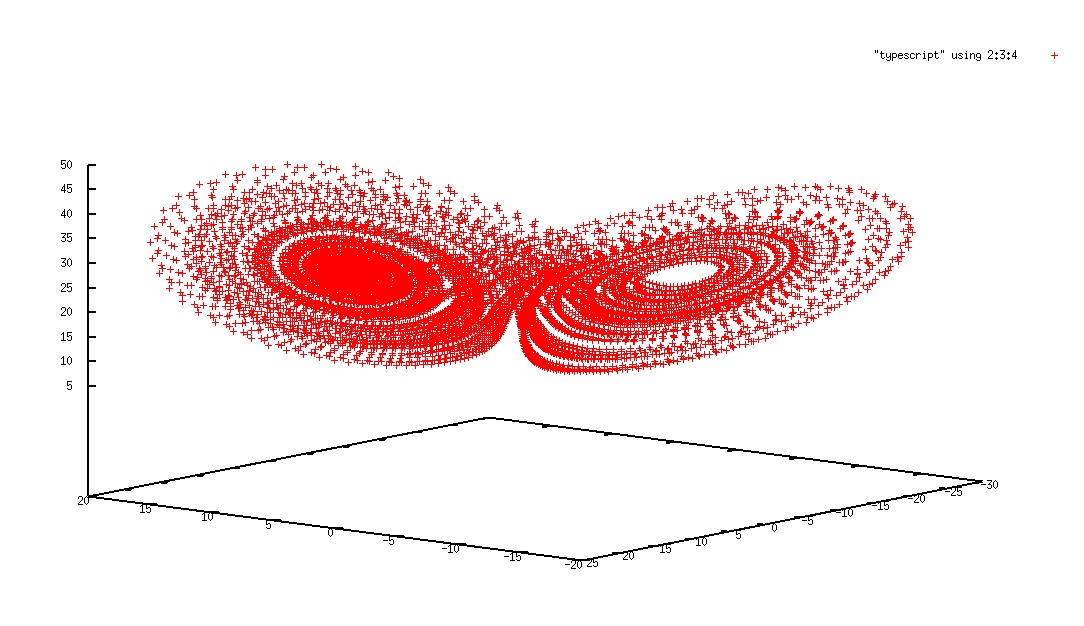Difference between revisions of "CS382:Chaos"
(→Climate Model) |
(→Lab Activity) |
||
| Line 56: | Line 56: | ||
=Lab Activity= | =Lab Activity= | ||
| − | * Using [http://local.wasp.uwa.edu.au/~pbourke/fractals/lorenz/ source code], compute lorenz attractor and display three dimensional plot with GNU Plot. The source code page also shows a code of lorenz attractor for Second Life, so we can bring it into metaverse and play with it. | + | * Using [http://local.wasp.uwa.edu.au/~pbourke/fractals/lorenz/ source code], students compute lorenz attractor and display three dimensional plot with GNU Plot. The source code page also shows a code of lorenz attractor for Second Life, so we can bring it into metaverse and play with it. |
| − | example of lorenz attractor with GNU Plot: | + | *example of lorenz attractor with GNU Plot: |
[[Image:lorenz.jpg]] | [[Image:lorenz.jpg]] | ||
Revision as of 20:41, 24 February 2009
Contents
Climate Model
This unit is about chaotic system. Chaotic system typically appear in climate model.
A famous chaotic theory was found from the research of climate model. It could be worthy to introduce how Edward Lorenz found deterministic climate model cannot predict future climate because of the initial parameters.
LAB activity is Lorenz attractor, named for Lorenz. It is a 3-dimensional structure corresponding to the long-term behavior of a chaotic flow. The map shows how the state of a dynamical system (the three variables of a three-dimensional system) evolves over time in a complex, non-repeating pattern.
This unit will be an issue about the upper limit of computational model.
Background Reading
- Making Order Out of Chaos: Edward Lorenz
- Edward N. Lorenz "Deterministic Nonperiodic Flow"
- Deterministic Nonperiodic Flow (1963)
- James Gleick "Chaos: Making a New Science"
Lecture Note
- Lecture 1:
- Story of Edward Lorenz
- How he found butterfly effect
- Introducing the weather model which Lorenz used
- Lecture 2:
- Climate model
- Introducing NetLogo-like climate model
- Basic of earth science (showing the relationship among temperature, pressure, wind, and humidity)
- Lecture 3:
- Numerical weather prediction
- Introducing how weather channel forecasts tomorrow's climate
- Different between numerical weather prediction and deterministic climate model
- NOAA
- Lecture 4:
- Global warming
- Can computer scientist predict climate 100 years later?
- Super computer for climate model (earth simulator, etc)
Classroom Response Question
- Who found butterfly effect?
- a. Edward Lorenz
- b. Hendrik Lorentz
- c. Edward Teller
- d. Edward VIII
- What is the chance of rain tomorrow?
- a. 30%
- b. 40%
- c. 50%
- d. (from weather channel)
- How accurate are weather forecasts?
- a. 100%
- b. 90%
- c. 80%
- d. 70%
Lab Activity
- Using source code, students compute lorenz attractor and display three dimensional plot with GNU Plot. The source code page also shows a code of lorenz attractor for Second Life, so we can bring it into metaverse and play with it.
- example of lorenz attractor with GNU Plot:
- JAVA application Lorenz Attractor
- To show chaotic system (climate might be to complex)
- Look up Shodor (function flyer)
Scheduling
This unit is supposed to come in the end of semester because students have to think what computer cannot do.
